 W
WAn aquarium is a vivarium of any size having at least one transparent side in which aquatic plants or animals are kept and displayed. Fishkeepers use aquaria to keep fish, invertebrates, amphibians, aquatic reptiles, such as turtles, and aquatic plants. The term "aquarium", coined by English naturalist Philip Henry Gosse, combines the Latin root aqua, meaning water, with the suffix -arium, meaning "a place for relating to". The aquarium principle was fully developed in 1850 by the chemist Robert Warington, who explained that plants added to water in a container would give off enough oxygen to support animals, so long as the numbers of animals did not grow too large. The aquarium craze was launched in early Victorian England by Gosse, who created and stocked the first public aquarium at the London Zoo in 1853, and published the first manual, The Aquarium: An Unveiling of the Wonders of the Deep Sea in 1854. An aquarium is a water-filled tank in which fish swim about. Small aquariums are kept in the home by hobbyists. There are large public aquariums in many cities. This kind of aquarium is a building with fish and other aquatic animals in large tanks. A large aquarium may have otters, turtles, dolphins, sharks, and whales. Most aquarium tanks also have plants.
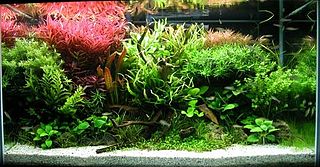 W
WAquascaping is the craft of arranging aquatic plants, as well as rocks, stones, cavework, or driftwood, in an aesthetically pleasing manner within an aquarium—in effect, gardening under water. Aquascape designs include a number of distinct styles, including the garden-like Dutch style and the Japanese-inspired nature style. Typically, an aquascape houses fish as well as plants, although it is possible to create an aquascape with plants only, or with rockwork or other hardscape and no plants.
 W
WBedding, in ethology and animal husbandry, is material, usually organic, used by animals to support their bodies when resting or otherwise stationary. It reduces pressure on skin, heat loss, and contamination by waste produced by an animal or those it shares living space with.
 W
WAbnormal behavior of birds in captivity has been found to occur among both domesticated and wild birds. Abnormal behavior can be defined in several ways. Statistically, 'abnormal' is when the occurrence, frequency or intensity of a behaviour varies statistically significantly, either more or less, from the normal value. This means that theoretically, almost any behaviour could become 'abnormal' in an individual. Less formally, 'abnormal' includes any activity judged to be outside the normal behaviour pattern for captive birds of that particular class or age. For example, running rather than flying may be a normal behaviour and regularly observed in one species, however, in another species it might be normal but becomes 'abnormal' if it reaches a high frequency, or in another species it is rarely observed and any incidence is considered 'abnormal'. This article does not include 'one-off' behaviours performed by individual birds that might be considered abnormal for that individual, unless these are performed repeatedly by other individuals in the species and are recognised as part of the ethogram of that species.
 W
WA birdcage is a cage designed to house birds as pets.
 W
WA chew toy is designed to be chewed by animals for purposes of stimulation and relief from boredom. The act of gnawing on a chew toy is meant to be soothing and to assist small animals, like puppies, in event of easing the pain when breaking in their adult teeth as the chewing process releases feel-good chemicals from the brain. There are several different types of chew toys, including rawhide, wood, paper and mineral. Chew toys are commonly associated with dogs, though they are also used by birds, rodents, and rabbits.
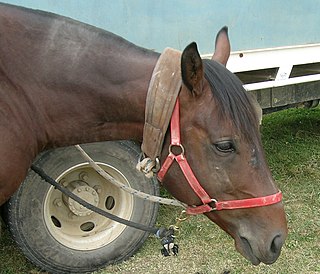 W
WAn animal collar is a device that attaches to the neck of an animal to allow it to be harnessed or restrained.
 W
WA formicarium or ant farm is a vivarium which is designed primarily for the study of ant colonies and how ants behave. Those who study ant behavior are known as myrmecologists.
 W
WA hide box is a box placed in an animal's enclosure which allows it to hide from view.
 W
WInvisible Fence Inc. is a company that designs pet fences for cats and dogs. Manufactured and distributed by Radio System Corps, the company sells wireless and fenceless systems that revolutionized pet containment when it was first introduced in 1973. Its best known product consists of an underground wire installed by an Invisible Fence employee or franchisee around the perimeter of an area, a collar with an integrated transmitter that provides a signal to the pet when it approaches the perimeter, training provided by Invisible Fence and additional training instructions for the pet owner.
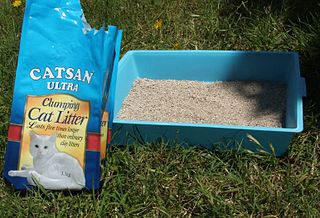 W
WA litter box, sometimes called a sandbox, cat box, litter tray, cat pan, or litter pan, is an indoor feces and urine collection box for cats, as well as rabbits, ferrets, miniature pigs, small dogs, and other pets that instinctively or through training will make use of such a repository. They are provided for pets that are permitted free roam of a home but who cannot or do not always go outside to excrete their metabolic waste. Many owners of these animals prefer not to let them roam outside for fear that they might succumb to outdoor dangers. On average, indoor cats have a lifespan of 16.8 years while outdoor cat's lives are much shorter, only 5.6 years. These outdoor dangers include weather, wildlife, traffic or diseases such as the feline immunodeficiency virus.
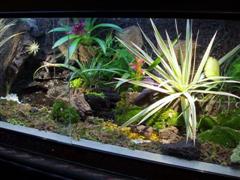 W
WA paludarium is a type of vivarium that incorporates both terrestrial and aquatic elements. Paludaria usually consist of an enclosed container in which organisms specific to the biome being simulated are kept. They may be maintained for purely aesthetic reasons or for scientific or horticultural purposes. The word 'paludarium' comes from the Latin word 'palus' meaning marsh or swamp and '-arium' which refers to an enclosed container.
 W
WA parrot harness or bird flight harness is a type of pet harness that is specifically designed to be worn by a parrot.
 W
WA parrot tent is an item of birdcage furniture, usually made from fleece, synthetic fur or quilted fabric which when placed in the cage of a companion parrot, provides the bird a comfortable, soft-textured private space in which it may climb inside to play, warm itself, rest or sleep.
 W
WPet carriers are small portable boxes, crates, or cages used to transport small animals such as cats, lap dogs, miniature pigs, ferrets, chickens, guinea pigs, and so on, from one location to another.
 W
WA pet door or pet flap is a small opening to allow pets to enter and exit a building on their own without needing a human to open the door. Originally simple holes, the modern form is a hinged and often spring-loaded panel or flexible flap, and some are electronically controlled. They offer a degree of protection against wind, rain, and larger-bodied intruders entering the dwelling. Similar hatches can let dogs through fences at stiles. A related concept is the pet gate, which is easy for humans to open but acts as a secure pet barrier, as well as the automated left- or right-handed pet doors.
 W
WThe Piganino is a conjectural musical instrument using a keyboard as to produce sound from pigs by poking them. Satirical use includes further portmanteaus as in German: Schweineorgel, French: l’orgue à cochons, and "Hog Harmonium", "Swineway", or "Porko Forte" in English.
 W
WA pooper-scooper, or poop scoop, is a device used to pick up animal feces from public places and yards, particularly those of dogs. Pooper-scooper devices often have a bag or bag attachment. 'Poop bags' are alternatives to pooper scoopers, and are simply a bag, usually turned inside out, to carry the feces to a proper disposal area. Sometimes, the person performing the cleanup is also known as the pooper-scooper.
 W
WA sipper water bottle is a type of bottle used to dispense water for certain pets including rabbits, ferrets, hamsters, chinchillas, gerbils, and other small animals. Typically a sipper bottle consists of a plastic portion used to contain the water, a plastic cap, and a metal tube with a ball bearing inside.
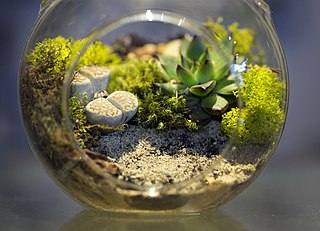 W
WA vivarium is an area, usually enclosed, for keeping and raising animals or plants for observation or research. Often, a portion of the ecosystem for a particular species is simulated on a smaller scale, with controls for environmental conditions.
 W
WA wolf collar is a type of dog collar designed to protect livestock guardian dogs from attack by wolves. Wolf collars are fitted with elongated spikes to stop wolves from attacking dogs on the neck. Such collars are used by shepherds in many countries including Italy, Spain and Turkey.